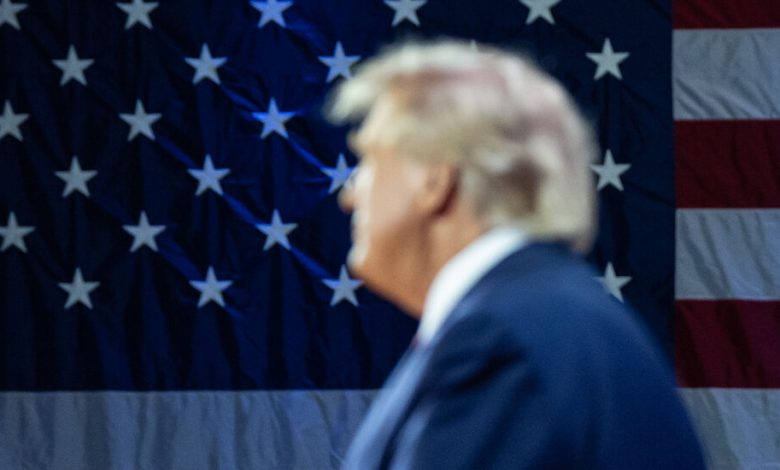Assessing the Breadth of Trump’s Election Lies

Before the 2020 election had even concluded, President Donald J. Trump laid the groundwork for an alternate reality in which he was declared the victor, falsely assailing the integrity of the race at nearly every turn.
Those lies are now central to two criminal indictments brought against him by the Justice Department and in Georgia, and formed what prosecutors have described as the bedrock of his attempts to overturn the election.
In public, he made more than 800 inaccurate claims about the election from the time the polls began closing on Nov. 3, 2020, to the end of his presidency, according to a database compiled by The Washington Post. Dozens of times, he simply characterized the election as “rigged,” “stolen” or “a hoax,” and flatly and falsely declared he had won — even as a mountain of evidence proved otherwise. Other falsehoods were more specific about the voting and ballot-counting process, contained unproven allegations and promoted conspiracy theories.
Here are five common ways in which Mr. Trump has lied about the 2020 election.
How Mr. Trump sought to undermine the election:
- Mischaracterizations of the voting and counting process
- False claims about barred observers and lack of verification
- Baseless examples of supposed fraud
- Conspiracy theories about voting machines
- Non sequiturs that do not prove fraud
Mischaracterizations of the voting and counting process
What Mr. Trump Said
“Last night I was leading, often solidly, in many key States, in almost all instances Democrat run & controlled. Then, one by one, they started to magically disappear as surprise ballot dumps were counted. VERY STRANGE, and the ‘pollsters’ got it completely & historically wrong!”
— On Twitter on Nov. 4
False. Dozens of times before and after the 2020 election, Mr. Trump described the legitimate vote-counting process as suspicious. For months, officials across the country had warned that tallying ballots may take days or even weeks to complete, given the prevalence of absentee voting that year. Studies and experts predicted that on election night, Mr. Trump could lead in key states, but that lead could slowly erode as officials continued to count mail-in ballots.
That’s precisely what happened. Mr. Trump’s early leads in Michigan, Pennsylvania and Georgia narrowed and then reversed. But the same thing also happened to Joseph R. Biden Jr., who initially led early vote tallies in North Carolina and Ohio only to eventually lose the final count. And in Florida, the candidate in the lead changed four times as more ballots were counted and before Mr. Trump ultimately prevailed.
What Mr. Trump Said
“I’ve been talking about mail-in ballots for a long time. It’s really destroyed our system. It’s a corrupt system.”
— In a news conference onNov. 5, two days after the election.
False. Numerous independent studies and government reviews have found voter fraud to be extremely rare in all forms, including mail-in voting.
Mr. Trump himself has voted by mail in Florida, which he has claimed is more secure because they use “absentee ballots” rather than mail-in ballots. (The state itself refers to them as “vote-by-mail ballots.”)
But there is no meaningful difference between “absentee ballots” and “vote-by-mail ballots.” The terms are often used interchangeably. Moreover, they are both secure forms of voting. Both mail-in and absentee ballots are paper ballots marked by hand by the voter, which the National Conference of State Legislatures, a nonpartisan group of public officials, considers the “gold standard of election security.” Twenty-seven states conduct signature verification for mail ballots, 12 require the signature of a witness or notary, and a handful of others ask voters to provide identification.
What Mr. Trump Said
“It’s amazing how those mail-in ballots are so one-sided, too. I know that it’s supposed to be to the advantage of the Democrats, but in all cases, they’re so one-sided.”
— Nov. 5 news conference
This lacks evidence. Many studies have found little evidence that mail-in ballots help one party over another. Of the nine states where more than half of voters cast their ballots by mail in the 2016 presidential election, Mr. Trump won four. Several Republican states like Iowa, Missouri and Alabama expanded mail-in ballots in the 2020 election.
What Mr. Trump Said
“We used to have what was called Election Day. Now we have election days, weeks and months, and lots of bad things happened during this ridiculous period of time.”
— In a Dec. 2 speech at the White House
False. The 2020 election was certainly not the first presidential election where results were not immediately ascertained. The first federal elections were held in 1788, but there was no single day until Congress passed a law in 1845 that set aside the Tuesday after the first Monday of November for elections. Slow vote counting and limits in communication then meant that days, weeks or even months passed before voters learned who had won in several elections in the 19th century. In the modern day, close elections dragged out to the next morning in 1960 and 1976. And famously, it took more than a month for the 2000 election to be resolved, when the Supreme Court ended a recount in Florida that December and effectively handed the presidency to George W. Bush.
False claims about barred observers and lack of verification
What Mr. Trump Said
“The OBSERVERS were not allowed, in any way, shape, or form, to do their job and therefore, votes accepted during this period must be determined to be ILLEGAL VOTES.”
— On Twitter on Nov. 6
False. Mr. Trump has complained about poll observers being denied access to watch ballot counting in key states. His own legal filings acknowledged the presence of Republican observers in Nevada, Pennsylvania, Georgia and Arizona, and there were at least 134 Republican poll challengers present inside TCF Center in Detroit, a convention center where votes were counted.
A lawyer for Mr. Trump acknowledged that there were “a nonzero number” of campaign observers allowed in the counting room in Philadelphia. In Michigan, the campaign relied on affidavits from election observers who claimed they witnessed fraud.
What Mr. Trump Said
“The Fake recount going on in Georgia means nothing because they are not allowing signatures to be looked at and verified. Break the unconstitutional Consent Decree!”
— On Twitter on Nov. 16
False. This was an inaccurate reference to a legal settlement between Georgia and the Democratic Party. Under the settlement signed in March 2020, officials in the state must notify voters whose signatures were rejected within three business days and give them the chance to correct issues. It did not bar officials from verifying signatures.
Georgia’s secretary of state, a Republican, noted that the state trained election officials on signature matching, required a confirmed match and created a portal that checked and confirmed driver’s licenses of voters. Moreover, signatures are not verified again during the recount process, as ballots are separated from the signed envelopes during the initial counting process.
What Mr. Trump Said
“In Pennsylvania, the secretary of state and the State Supreme Court in essence abolished signature verification requirements just weeks prior to the election, in violation of state law. You’re not allowed to do that.”
— In the Dec. 2 news conference
This is misleading. Federal courts have ruled against Mr. Trump’s assertion.
In August 2020, the League of Women Voters and other groups sued Pennsylvania over a lack of clarity in state policy over mail-in ballots that had been rejected because of issues with the signatures, noting the absence of official guidance or uniform standards. A month later, Pennsylvania’s top election official told county election officials that they could not reject ballots because of a perceived mismatch in signatures. In response, the Trump campaign added a challenge to this guidance to an existing lawsuit.
In October, a federal judge appointed by Mr. Trump ruled against the campaign, writing that the state election code “does not impose a signature comparison requirement.” About two weeks later, the Pennsylvania Supreme Court, which included two Republicans, ruled unanimously that the election code does not require signature verification.
Baseless examples of supposed fraud
What Mr. Trump Said
“In Fulton County, Republican poll watchers were ejected, in some cases, physically from the room under the false pretense of a pipe burst. Water main burst, everybody leave, which we now know was a total lie. Then election officials pull boxes, Democrats, and suitcases of ballots out from under a table.”
— In a speech on Jan. 6, 2021, shortly before a mob of loyalists stormed the Capitol
False. Election officials have said and surveillance videos show that this did not happen.
A water leak caused a delay for about two hours in vote counting at the State Farm Arena, but no ballots or equipment were damaged. Georgia’s chief election investigator, Frances Watson, testified that a “review of the entire security footage revealed that there were no mystery ballots that were brought in from an unknown location and hidden under tables.”
Election observers and journalists were present at State Farm Arena when the water leak occurred. They were not asked to leave, Ms. Watson said, but simply “left on their own” when they saw one group of workers, who had completed their task, exit.
What Mr. Trump Said
“Everybody knows that dead people, below age people, illegal immigrants, fake signatures, prisoners, and many others voted illegally.”
— In a series of tweets on Dec. 13
This lacks evidence. Mr. Trump has claimed that tens of thousands of dead people voted in key states: 20,000 in Pennsylvania, 17,000 in Michigan and 5,000 in Georgia.
The Pennsylvania figure most likely referred to a lawsuit filed by a conservative group accusing the state of including 21,206 supposedly deceased people on voter rolls. But a federal judge appointed by President George W. Bush took issue with the group’s methodology and declined to remove the names from the rolls. This does not support the notion that 20,000 dead people cast ballots.
The Michigan figure might refer to a list of supposedly deceased voters who submitted absentee ballots posted by a right-wing personality to social media. That list included people who were alive or who shared a name with a deceased person. A state audit later found that of 2,775 absentee ballots cast by voters from May 2019 to November 2020 who had died by Election Day, 2,734 had died within 40 days of the elections.
And while it is unclear where Mr. Trump got his 5,000 deceased voters figure for Georgia, officials have found only four cases of dead people voting.
What Mr. Trump Said
“In Detroit, turnout was 139 percent of registered voters. Think of that. So you had 139 percent of the people in Detroit voting.”
— In the Jan. 6 speech
“A group of Republican lawmakers in Pennsylvania say 200,000 more votes were counted in the 2020 Election than voters (100% went to Biden).”
— On Twitter on Dec. 29
False. About 51 percent of registered voters and 38 percent of the entire population cast a ballot in Detroit.
The figure for Pennsylvania was a reference to faulty analysis conducted by state Republican lawmakers. The analysis relied on a voter registration database that Pennsylvania’s Department of State said was incomplete as a few counties — including Philadelphia and Allegheny, the two largest in the state — had yet to fully upload their data. The department called the analysis “obvious misinformation.”
Conspiracy theories about voting machines
What Mr. Trump Said
“All of the mechanical ‘glitches’ that took place on Election Night were really THEM getting caught trying to steal votes. They succeeded plenty, however, without getting caught. Mail-in elections are a sick joke!”
— On Twitter on Nov. 15
This lacks evidence. Issues with unofficial vote counts in a few counties in Michigan and Georgia on election night were caused by human error, not nefarious software, and were quickly rectified. In Michigan, election workers erroneously double-counted votes in one county and improperly configured the software in another, before realizing the mistakes and correcting them. In Georgia, the software delayed the reporting of results.
In April, Fox News agreed to pay $787.5 million to settle a lawsuit filed by Dominion Voting Systems for knowingly spreading falsehoods about the company’s election technology switching votes during the 2020 election. While the network did not apologize or make an admission of guilt in its settlement, Dominion obtained and released a trove of internal communications in which personalities and executives at Fox expressed skepticism about the claims.No credible evidence has ever emerged that issues with voting machines affected vote tallies.
What Mr. Trump Said
“When you look at who’s running the company, who’s in charge, who owns it, which we don’t know, where are the votes counted, which we think are counted in foreign countries, not in the United States.”
— In the Dec. 2 news conference
This lacks evidence. This was an oblique reference to conspiracy theories about Dominion’s supposedly nefarious ties to the financier George Soros and Venezuela advanced by members of his legal team, who also face charges in Georgia.
Dominion does not have any ties to Venezuela or Mr. Soros. The company’s chief executive said in an April 2020 letter to Congress that he owned a 12 percent stake in the company, while a private equity firm, Staple Street Capital Group in New York, owned about 75 percent, The Associated Press reported. No other investor held more than 5 percent of Dominion. A 2018 news release also announced Dominion’s acquisition by Staple Street.
Mr. Trump also could have been referring to another popular baseless claim, which was that the U.S. military had seized computer servers that had evidence of voter fraud from a company in Germany. The company in question and the Army both denied the claims.
Non sequiturs that do not prove fraud
What Mr. Trump Said
“With over 74 million votes, over, think of that, more than, I got more votes than any sitting president in history, 11 million more votes than we got in 2016.”
— In a campaign rally in Georgia on Dec. 5
This is misleading. One of Mr. Trump’s most repeated complaints assumes that it is improbable that he lost the 2020 election because the vote count that year was higher than his vote count in 2016. Mr. Trump received 74 million votes in the 2020 presidential election, 12 million more than he received in the 2016 election. President Biden, of course, received even more votes in 2020, 81 million.
A large number of votes received by the losing candidate is not evidence of fraud. To wit, Hillary Clinton also received two million more votes in 2016 than President Barack Obama did in 2012.
What Mr. Trump Said
“In Georgia, 0.5 percent of the mail-in ballots were rejected in 2020 compared to 5.77 percent. That’s a difference of 11 times more. It’s hundreds of thousands of votes. In Pennsylvania, .03 percent were rejected in 2020 compared to a much, much higher percentage in 2016.”
— In the Dec. 5 campaign rally
This is misleading.
In 2020, about 0.4 percent of absentee ballots in Georgia were rejected, compared with about 5.8 percent in 2016, according to reports from the U.S. Election Assistance Commission. But in Pennsylvania, the rejection rate actually increased from 0.9 percent in 2016 to 1.3 percent in 2020. (Mr. Trump’s 0.03 percent rejection rate came from a partial tally from Nov. 5, before Pennsylvania had completed counting its ballots.)
In its 2020 report, the election commission noted that although the total number of mail-in ballots tallied in 2020 was more than double the amount in 2016, the rejection rate did not change significantly nationally: 0.8 percent in 2020 and 1 percent in 2016.
The decline in Georgia’s rejection rate of mail-in ballots is also not evidence of fraud. The rate had also decreased to 3.1 percent in the 2018 midterm elections. A 2021 analysis of absentee ballot rejections from the Election Lab at the Massachusetts Institute of Technology noted that Georgia enacted a ballot-curing process — in which voters are notified about errors with their ballots and are given the chance to fix them — after the 2016 election. The 18 states with such processes all had lower rejection rates, according to the analysis.
We welcome suggestions and tips from readers on what to fact-check on email and Twitter.




